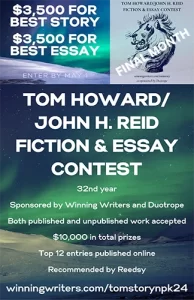The Pat Boone Fan Club
This essay collection is by noted memoirist Sue William Silverman, who was one of my mentors at the Vermont College of Fine Arts low-residency MFA program. While normally such ties between reviewer and author are discouraged in NewPages’s reviews, the exception was made for two reasons, one being the import of the subject matter of the essays: Silverman explores her extended spiritual identity crisis from growing up Jewish in a Christian world and includes a continuation of focus from her two previous memoirs, Because I Remember Terror, Father, I Remember You and Love Sick: One Woman’s Journey through Sexual Addiction, in which Silverman recounts being sexually abused by her father throughout her childhood and her resultant sexual addiction and recovery. While tremendously important social issues to be brought into the public dialogue, it’s much harder for such books to be given much, if any, review consideration. The second reason for the exception is precisely that my relationship to Silverman affords me the ability to comment on her craft, as she taught it, and assess her own ability to “walk her talk.”
This essay collection is by noted memoirist Sue William Silverman, who was one of my mentors at the Vermont College of Fine Arts low-residency MFA program. While normally such ties between reviewer and author are discouraged in NewPages’s reviews, the exception was made for two reasons, one being the import of the subject matter of the essays: Silverman explores her extended spiritual identity crisis from growing up Jewish in a Christian world and includes a continuation of focus from her two previous memoirs, Because I Remember Terror, Father, I Remember You and Love Sick: One Woman’s Journey through Sexual Addiction, in which Silverman recounts being sexually abused by her father throughout her childhood and her resultant sexual addiction and recovery. While tremendously important social issues to be brought into the public dialogue, it’s much harder for such books to be given much, if any, review consideration. The second reason for the exception is precisely that my relationship to Silverman affords me the ability to comment on her craft, as she taught it, and assess her own ability to “walk her talk.”
Unlike the straightforward narrative form she employs in her previous memoirs, this eclectic collection contains lyric essays, a simulated screen play, and a radio drama script, with interspersed missives addressed to the “Gent(i)le Reader” that contain exposition and provide contextual cohesiveness. The book is structured around Silverman’s three personal encounters with the pop singer and Christian icon Pat Boone, with whom, as a teenager, Silverman developed a lifelong obsession, perceiving him as the safe Christian antithesis of her abusive Jewish father.
The title spotlights Silverman’s obsession with the man to whom she always refers by his full name, a signal that it’s the icon she’s obsessed with more than the man. She first meets him as a teenager, when he autographs a book for her, but being in his presence renders her speechless and unable to carry out her plan to ask him to adopt her. Yet, he continues to offer her hope, as Silverman explains: “I conjured him into the man I needed him to be: a safe father. By my believing in that constant image, he did save me.” In the title essay, Silverman describes her second encounter, when she gives him a letter describing his role in her life. Touched by her story, a year later, he invites her and her partner backstage after a concert. Silverman shares excerpts from her and Boone’s correspondence to portray their ongoing friendship.
Silverman recently explained that she hadn’t intended to write a book, but after she published several of these essays independently in journals, she realized they fit together like pieces of a jigsaw puzzle. In each, while focusing on diverse situations and details, she explores her spirituality, trying on and abandoning various identities as she looks for one that fits, finally identifying herself as a “first-generation Russian American atheist liberal Democrat.”
Although many of the topics and themes in these essays are somber and sincere, Silverman’s ever-present humor sets a self-deprecating tone. In “Swimming Like a Gefilte Fish,” Silverman compares herself to one: “All evidence of its fishness—its true identity—gone. (Which is probably why you’ve secretly identified with gefilte fish all these years in the first place.)”
When I studied with Silverman at VCFA, she emphasized the importance of using sensory details to explore and reveal emotion, and this book is a study in what she calls the “slanted detail.” For example, in the title essay, she recounts studying a black-and-white magazine photograph of Boone, his wife, and their four daughters straddling a tandem bicycle. Drawn in by the whiteness (his “white-white teeth” and spotless buckskins), which she interprets as immaculate and safe, she imagines herself living in the photograph with them, his wristwatch freezing them in time. She finds hope in “His milky-white image. That sterile pose.”
Silverman employs the second person in some of these essays. The technique serves as a subtle detail delivery system and allows her to move seamlessly back and forth through time. For example, in “Swimming Like a Gefilte Fish,” she begins, “The Jews are coming to visit” and, “They arrive at your house smelling of musty Brooklyn or Bronx apartments where (you know because you’ve been forced to visit) closets smell of damp wool and lox.” In “Galveston Island Breakdown,” the second person POV draws the reader in close to the emotional heart of the story while eschewing melodrama, as in this passage in which she considers reuniting with her estranged husband: “Maybe he can still save you, though you don’t know from what. Your need is indefatigable as waves.”
Readers will relate to these stories, for while they’re directly about this writer’s spiritual journey, they’re also about the universal feeling that one doesn’t quite belong, and the fact that Silverman has survived, recovered, and discovered her true self gives hope to the rest of us. In the final passage, Silverman recounts a dream in which Pat Boone, in a dazzling halo, discusses with her the political aspects of the Terry Schaivo case while rescuing her from an alligator. She asks, “What would you do to keep me alive?” to which he replies, “For you . . . I would iron the night.”





